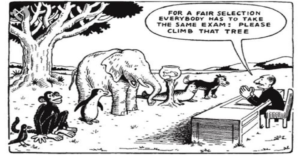Albert Einstein once famously said about the education system “Everyone is a genius. But if you judge a fish by its ability to climb a tree, it will live its whole life believing that it is stupid”.
By looking at the cartoon, and imagining the tree is the Leaving Certificate, Einstein makes complete sense. So how do we in OLM allow so many different people to achieve? The most important thing for us as educators in a DEIS school is that we understand that young people learn in different ways.
The cornerstone of any school is the quality of its Teaching and Learning. At OLM we are proud to be CEIST school and understand the importance of our value of ‘Achieving Excellence in Teaching and Learning’ in helping students to succeed.
With this in mind we set about a process of rolling out whole-school approaches to Teaching and Learning in 2016-2017. They are listed below and explained:
- A Common Lesson Structure:
- We call this the Four-Part Lesson. Each lesson or series of lessons will have four parts.
- Starter exercise that settles students directly to work. Teachers set the starter exercises according to their subject, the group’s ability or the topic being covered.
- Main task, teacher-led where teachers explain, model, show, demonstrate, give examples of the work they want students to complete.
- Main task, student-led where students take control of their own learning. This is where they achieve the aims of the lesson to the best of their ability and supported by teachers.
- Plenary exercise where students either recap on what they have learned or look forward to the next phase of learning.
- Principles of Assessment for Learning:
While there is no hiding from the current Leaving Certificate, we understand that students achieve better if they understand what level they are currently working at and what they need to improve to the next level. Rather than focus simply on ‘exams’, in OLM we focus on continuous assessment in a variety of different ways.
- Learning intentions where the aims of the lesson or series of lessons are shared by teachers at the beginning.
- Checking understanding of the learning intentions is done in a variety of ways by the teacher. We call these active learning strategies.
- Active and collaborative learning which allows students to work in pairs or groups, to learn from each other and give feedback to one another, the teacher or the class.
- Feedback from teachers is so important to ensure that students can achieve. Again, this is done in a variety of ways.
- Differentiation:
Is not a new concept. Teachers have been differentiating to different abilities of students for centuries. In OLM however, we ensure that all subjects outside the core subjects of English, Irish and Maths are mixed ability classes. We understand that students learn best when they are challenged by those around with different abilities and teachers use a variety of methods to differentiate in lessons so that all students can achieve.
- Cooperative Teaching model:
Is a recent concept and follows the National Council for Special Education Needs (NCSE) model of inclusion. In OLM we recognise that for students who may struggle somewhat, they learn best in their own classroom environment. Rather than extracting them from a whole series of lessons throughout the day, we timetable teachers to work together in one classroom. The main part of the lesson is managed or led by one teacher and then they both set about supporting students to achieve the aims, regardless of their ability. Some resource lessons are still timetabled, for those who are exempt from certain subjects or need intensive support, but our aim is that all students are included in all mainstream classrooms as much as possible.
How do we measure success?
We have a teacher support scheme in place since 2017. Teachers observe one another in action in the classroom, meet up afterwards and share ideas for how each could improve their own practices. Once a year, the comments on ‘what went well?’ and ‘how can we improve?’ are shared with all staff so that we can focus on one or two areas for improvement the next year.
Various inspections since 2018 have noted that teachers are following the whole-school approaches and that students are engaged in lessons, understand what they are supposed to be learning and why.
Since 2017, teachers employed in OLM give a firm commitment to following the whole-school approaches to Teaching and Learning as part of their contracts.
Is it working?
Put simply? Yes. It is working. We know this from the numbers of students who are now achieving higher grades at Leaving Cert than ever before. This can clearly be seen in our Progression or transition rates after they leave school. Between 2013 and 2017, progression rates to 3rd level stood at 30%. Overall progression to 3rd level, Colleges of Further Education, Apprenticeships, and the world of work stood at 65%. The whole-school approaches to Teaching and Learning started to roll out in 2016-2017. Our progression rates to 3rd level between 2018 and 2023 jumped to 49.3% and our overall progression rates jumped to 96%.
We much prefer the cartoon below to explain how we help students to achieve in OLM.


